1996 CHEVROLET TAHOE wheel
[x] Cancel search: wheelPage 179 of 403

Downloaded from www.Manualslib.com manuals search engine e.” What should I do if my vehicle stalls, or is about
A: If this happens, there are some things you should
to stall, and I can’t make it up the hill?
do, and there are some things you must not do.
First, here’s what you
should do:
Push the brake pedal to stop the vehicle and
keep it from rolling backwards. Also, apply the
parking brake.
0 If your engine is still running, shift the transmission
to REVERSE (R), release the parking brake, and
slowly back down the hill in REVERSE (R).
restart it. With the brake pedal depressed and the
parking brake still applied, shift the transmission to
PARK
(P) and restart the engine. Then, shift to
REVERSE (R), release the parking brake, and’
slowly back down the hill as straight as possible in
REVERSE (R).
0 If your engine has stopped running, you’ll need to
0 As you are backing down the hill, put your left hand
on the steering wheel at the 12 o’clock‘position. This
way,
you’ll be able to tell if your wheels are straight
and maneuver as
you back down. It’s best that you
back down the hill with your wheels straight rather
than in the left
or right direction. Turning the wheel
too far
to the left or right will increase the possibility
of a rollover.
Here are some things you
must nut do if you stall, or are
about
to stall, when going up a hill.
0 Never attempt to prevent a stall by shifting into
NEUTRAL (N) to “rev-up” the engine and regain
forward momentum. This won’t work. Your vehicle
will roll backwards very quickly and you could
go
out of control.
Instead, apply
the regular brake to stop the
vehicle. Then apply the parking brake. Shift to
REVERSE (R), release the parking brake, and
slowly back straight down.
,e Never attempt to turn around if you are about to stall
when going up a hill. If the hill is steep enough to
stall your vehicle, it’s steep enough
to cause you to
roll over if you turn around. If you can’t make it up
the hill, you must back straight down the hill.
4-20
Page 180 of 403
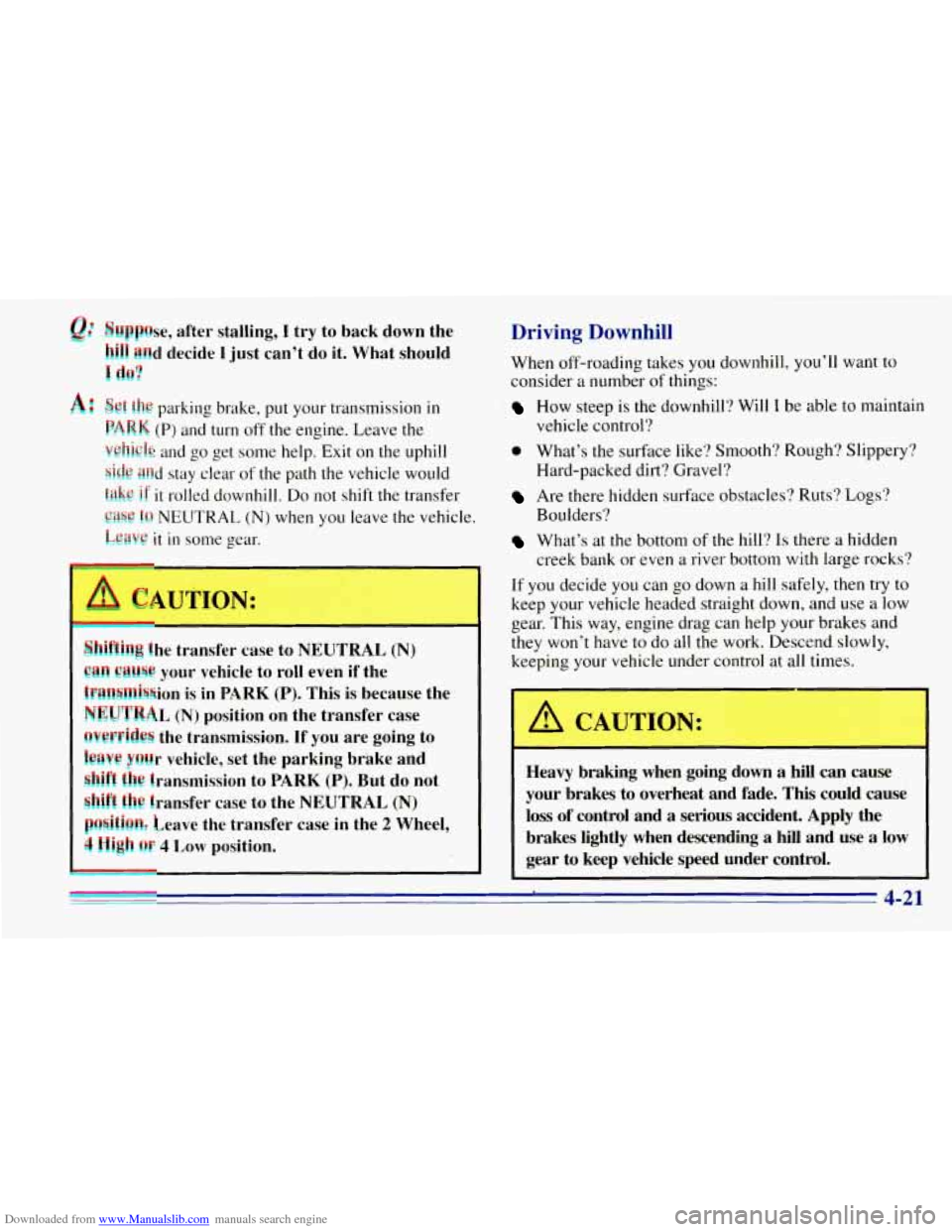
Downloaded from www.Manualslib.com manuals search engine Y Dppse, after stalling, I try to back down the
kill PRd decide I just can’t do it. What should
I d@7
A
!!kt €he parking brake, put your transmission in
PARK (P) and turn off the engine. Leave the
V@kk and go get some help. Exit on the uphill
.ri& gild stay clear of the path the vehicle would
tf it rolled downhill. Do not shift the transfer
*n NEUTRAL (N) when you leave the vehicle.
‘t in some gear.
$1 3 the transfer case to NEUTRAL (N)
BBH CiWslj@ your vehicle to roll even if the
fFtW8ftlj58ion is
in PARK (P). This is because the
NEuTuL (N) position on the transfer case
@V@PfkkS the transmission. If you are going to
hVf3 pi4r vehicle, set the parking brake and
hi! transmission to PARK (P). But do not
§hi## €hi! transfer case to the NEUTRAL (N)
pl iOR8 Leave the transfer case in the 2 Wheel,
4 1 ah 01: 4 LOW position.
Driving Downhill
When off-roading takes you downhill, you’ll want to
consider a number
of things:
How steep is the downhill? Will I be able to maintain
vehicle control?
0 What’s the surface like? Smooth? Rough? Slippery?
Hard-packed dirt? Gravel?
Are there hidden surface obstacles? Ruts? Logs?
Boulders?
What’s at the bottom of the hill? Is there a hidden
creek bank or even
a river bottom with large rocks?
If you decide you can
go down a hill safely, then try to
keep your vehicle headed straight down, and use a low
gear. This way, engine drag can help your brakes and
they won’t have to do all the work. Descend slowly,
keeping your vehicle under control at all times.
A CAUTION:
Heavy braking when going down a hill can cause
your brakes to overheat and fade.
This could cause
loss of control and a serious accident. Apply the
brakes lightly when descending
a hill and use a low
gear
to keep vehicle speed under control.
- 4-21
Page 181 of 403
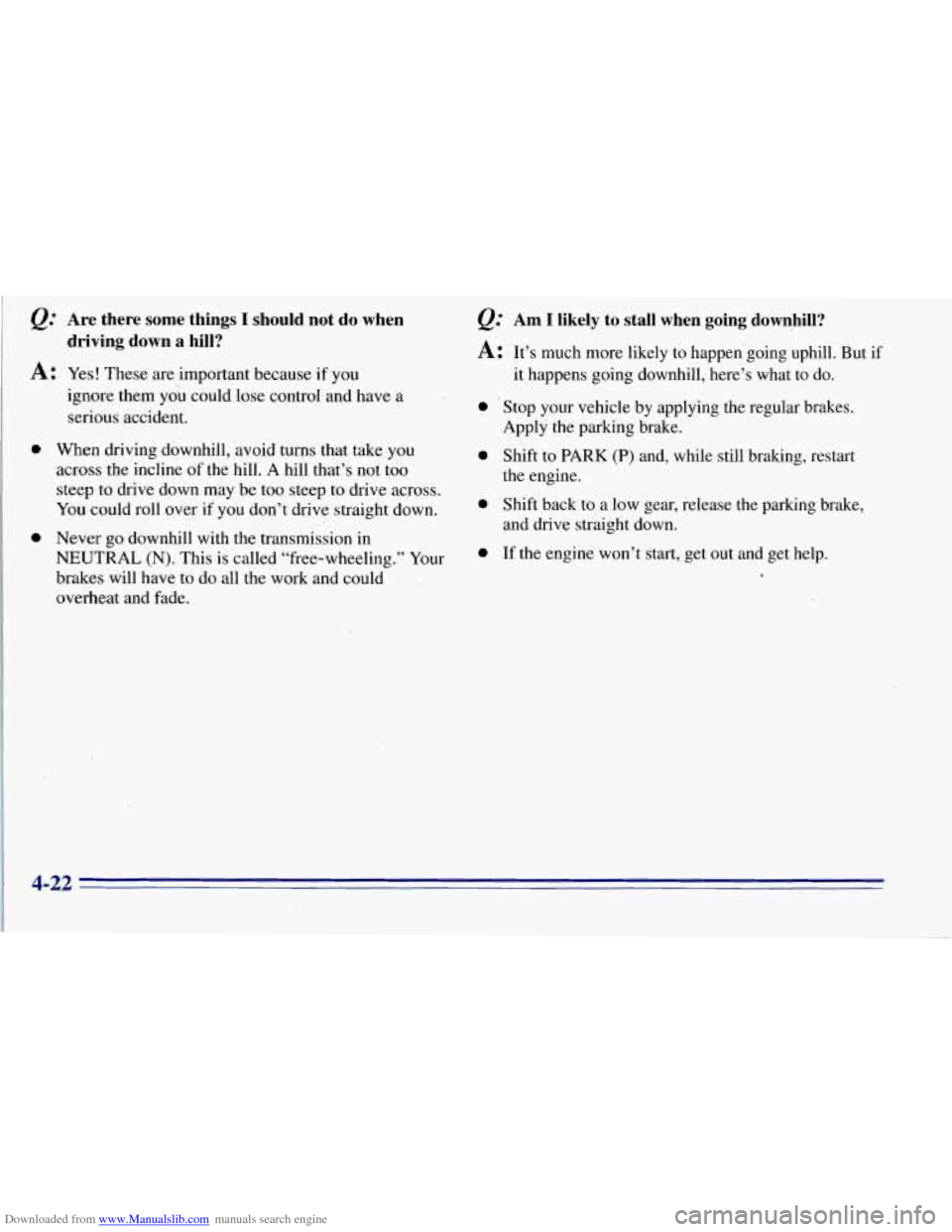
Downloaded from www.Manualslib.com manuals search engine Q: Are there some things I should not do when
driving down
a hill?
A: Yes! These are important because if you
0
0
ignore them you could lose control and have a
serious accident.
When driving downhill, avoid turns that take you
across the incline
of the hill. A hill that’s not too
steep
to drive down may be too steep to drive across.
You could roll over if you don’t drive straight down.
Never go downhill with the transmission in
NEUTRAL
(N). This is called “free-wheeling.” Your
brakes will have to do all the work and could
overheat and fade.
Q: Am I likely to stall when going downhill?
A: It’s much more likely to happen going uphill. But if
0
0
0
a
it happens going downhill, here’s what to do.
Stop your vehicle by applying the regular brakes.
Apply the parking brake.
Shift to PARK (P) and, while still braking, restart
the engine.
Shift back to a low gear, release
the parking brake,
and drive straight down.
If the engine won’t start, get
out and get help.
4-22
Page 182 of 403
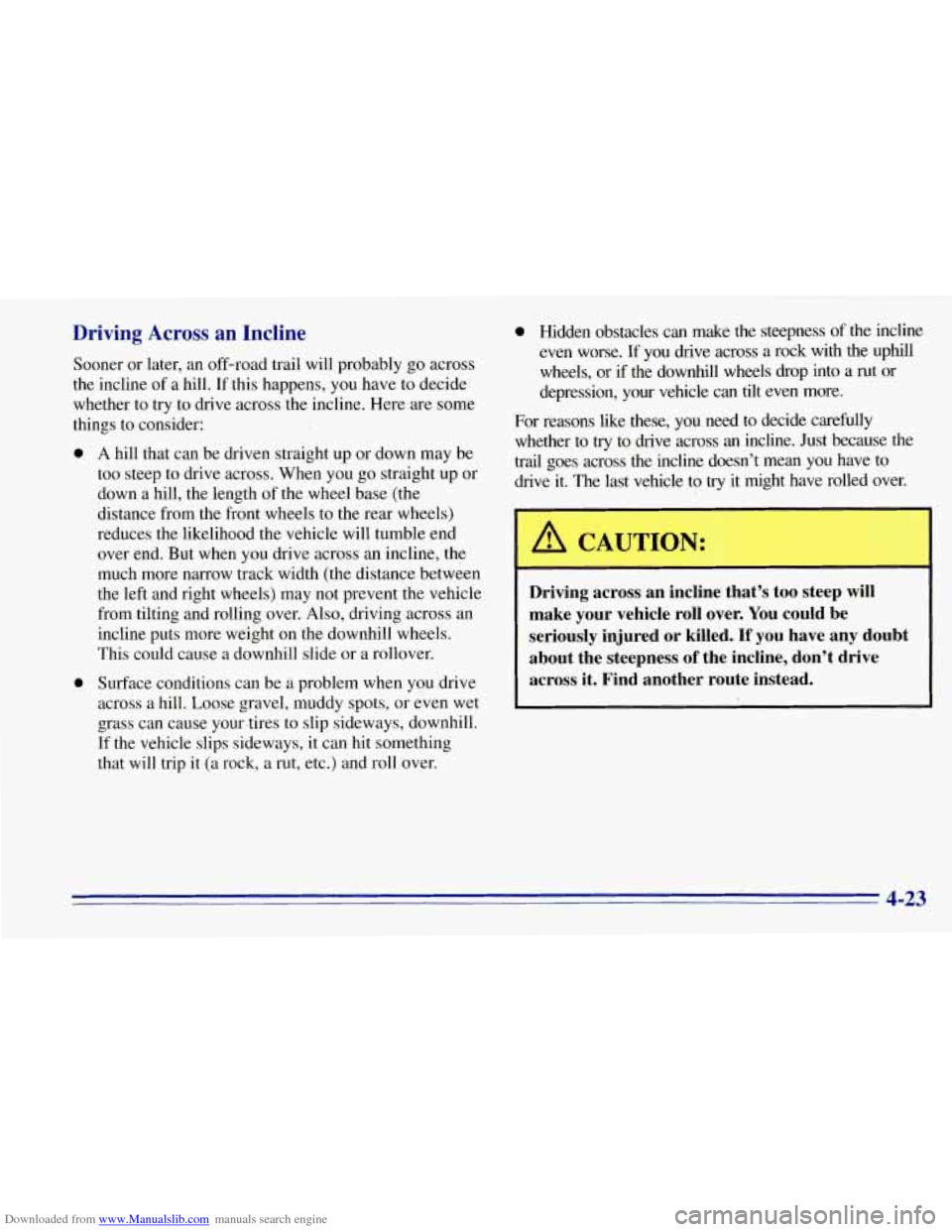
Downloaded from www.Manualslib.com manuals search engine Driving Across an Incline
Sooner or later, an off-road trail will probably go across
the incline of a.hill. If this happens,
you have to decide
whether to try to drive across the incline. Here are some
things to consider:
0
0 A hill that can be driven straight up or down may be
too steep to drive across. When you go straight. up or
down a hill, the length of the wheel base (the
distance from the front wheels to the rear wheels)
reduces the likelihood the vehicle will tumble end
over end. But when you drive across an incline, the
much more narrow track width (the distance between
the left and right wheels) may not prevent the vehicle
from tilting and rolling over. Also, driving across an
incline puts more weight on the downhill wheels.
This could cause a downhill slide or a rollover.
Surface conditions can be a problem when you drive
across a hill. Loose gravel, muddy spots, or even wet
grass can cause your.tires to slip sideways, downhill.
If the vehicle slips sideways, it can hit something
that will trip it (a rock, a rut, etc.) and roll over.
0 Hidden obstacles can make the steepness of the incline
even worse.
If you drive across a rock with the uphill
wheels, or if the downhill wheels drop into a rut or
depression, your vehicle can tilt even more.
For reasons like these,
you need to decide carefully
whether to
try to drive across an incline. Just because the
trail goes across the incline doesn’t mean
you have to
drive it. The last vehicle to
try it might have rolled over.
.
A CAUTION:
Driving across an incline that’s too steep will
make your vehicle roll over. You could be
seriously injured or killed.
If you have any doubt
about the steepness
of the incline, don’t drive
across it. Find another route instead.
4-23
Page 184 of 403
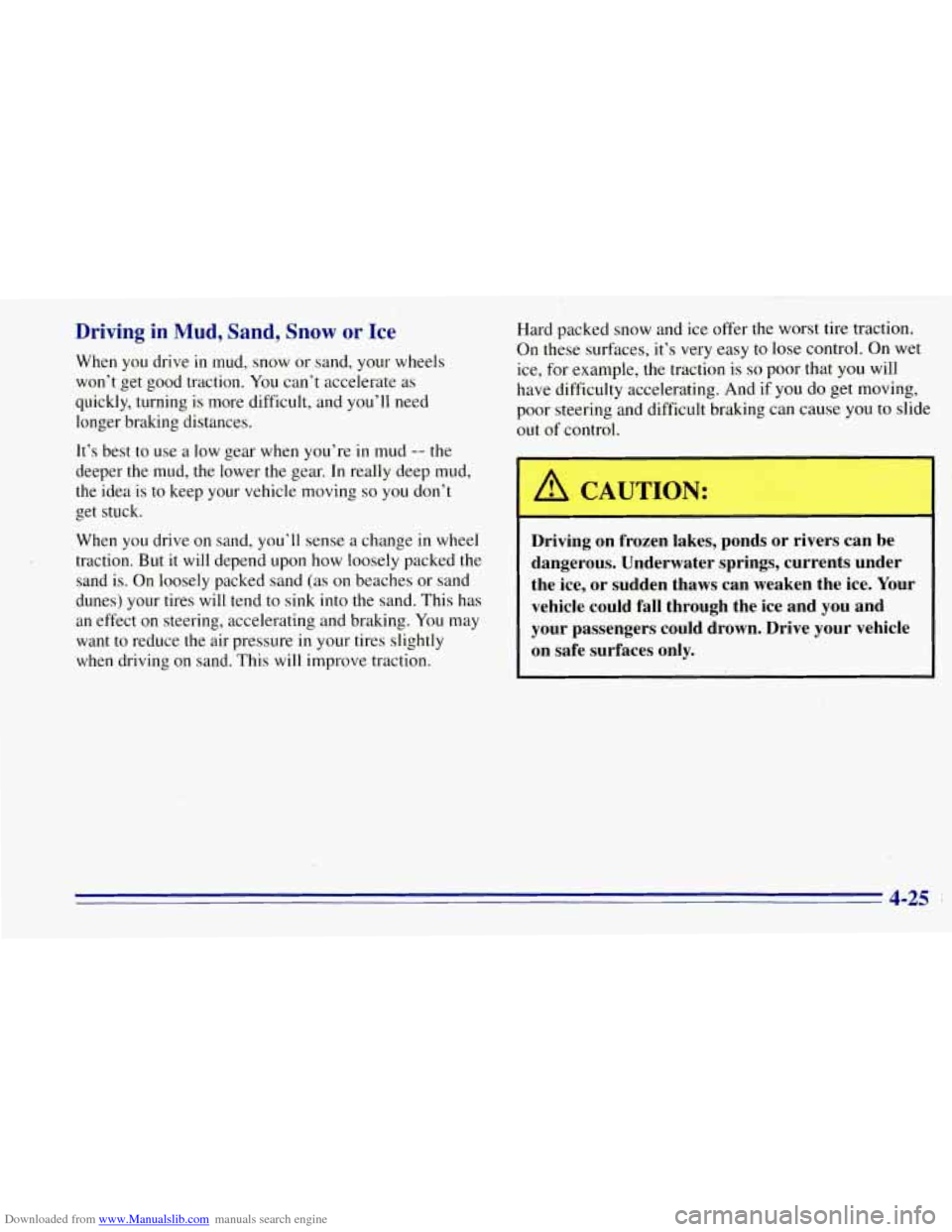
Downloaded from www.Manualslib.com manuals search engine Driving in Mud, Sand, Snow or Ice
When you drive in mud, snow or sand, your wheels
won’t.get good traction.
You can’t accelerate as
quickly, turning is more difficult, and
you’ll need
longer, braking distances.
It’s best to use a low gear when you’re
in mud -- the
deeper the mud, the lower the gear. In really deep mud,
the idea is to keep your vehicle moving
so you don’t
get stuck.
When you drive
on sand, you’ll sense a change in wheel
traction. But it
will depend upon how loosely packed the
sand is. On loosely packed sand (as
on beaches or sand
dunes) your tires will tend
to sink into the sand. This has
an effect on steering, accelerating and braking.
You may
want to reduce the air pressure in your tires slightly
when’driving on sand. This will improve traction. Hard
packed snow and ice offer the worst tire traction.
On these surfaces, it’s very easy to lose control.
On wet
ice, for example, the traction is
so poor that you will
have difficulty accelerating. And if you do get moving,
poor steering and difficult braking can cause
you to slide
out
of control.
I A CAUTION:
Driving on frozen lakes, ponds or rivers can be
dangerous. Underwater springs, currents under
the ice, or sudden thaws can weaken the ice. Your
vehicle could fall through the ice and you and
your passengers could drown. Drive your vehicle
on safe surfaces only.
Page 185 of 403
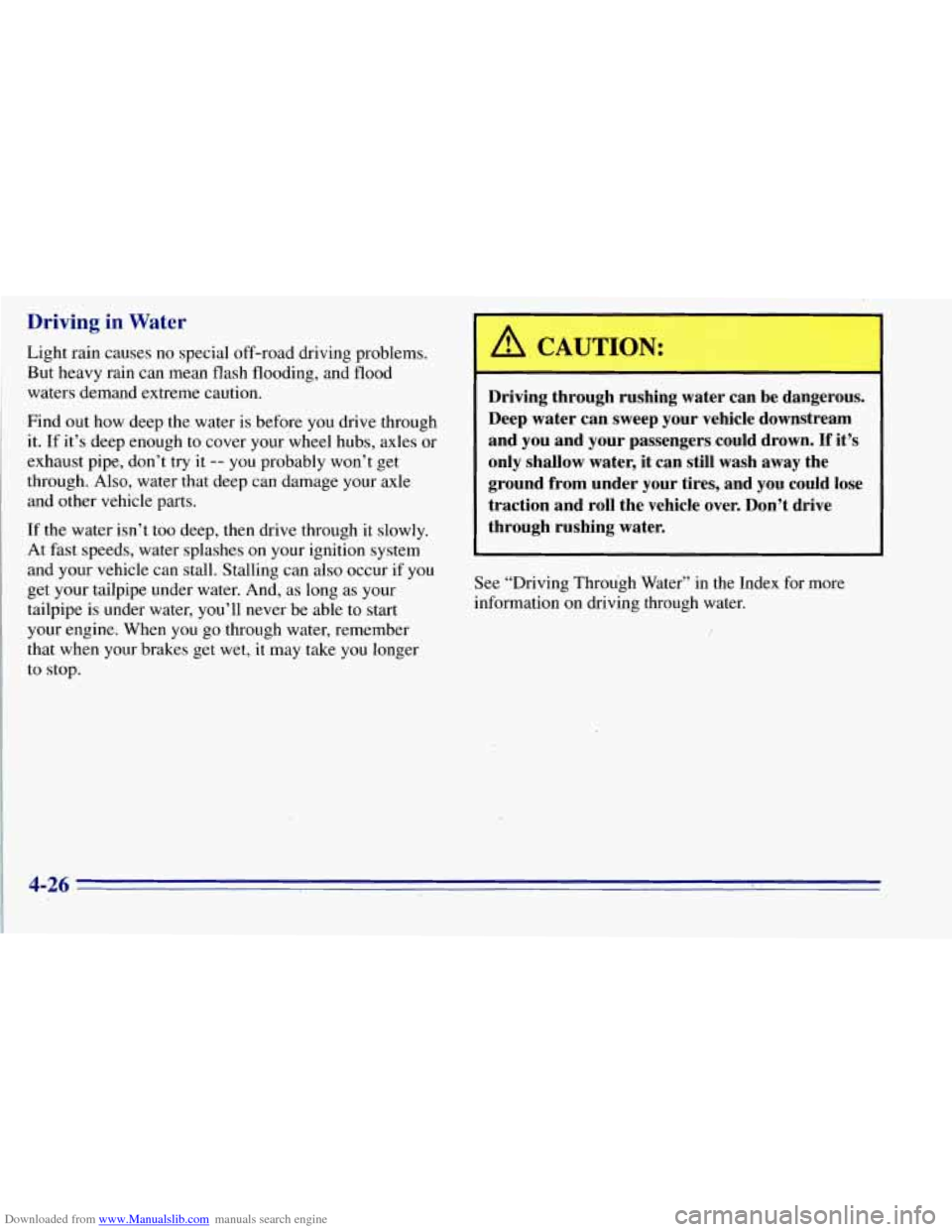
Downloaded from www.Manualslib.com manuals search engine Driving in Water
Light rain causes no special off-road driving problems.
But heavy rain can mean flash flooding, and
flood
waters demand extreme caution.
Find out how deep the water is before you drive through
it. If it’s deep enough to cover your wheel hubs, axles or
exhaust pipe, don’t try it
-- you probably won’t get
through. Also, water that deep can daniage your axle
and other vehicle parts.
If the water isn’t
too deep, then drive through it slowly.
At fast speeds, water splashes on your ignition system
and your vehicle can stall. Stalling can also occur if
you
get your tailpipe under water. And, as long as your
tailpipe
is under water, you’ll never be able to start
your engine. When
you go through water, remember
that when your brakes get wet, it may take you longer
to stop.
L
A CAUTION:
Driving through rushing water can be dangerous.
Deep water can sweep your vehicle downstream
and you and your passengers could drown.
If it’s
only shallow water, it can still wash away the
ground from under your tires, and you could lose
traction and roll the vehicle over. Don’t drive
through rushing water.
See “Driving Through Water” in the Index for more
information on driving through water.
Page 186 of 403
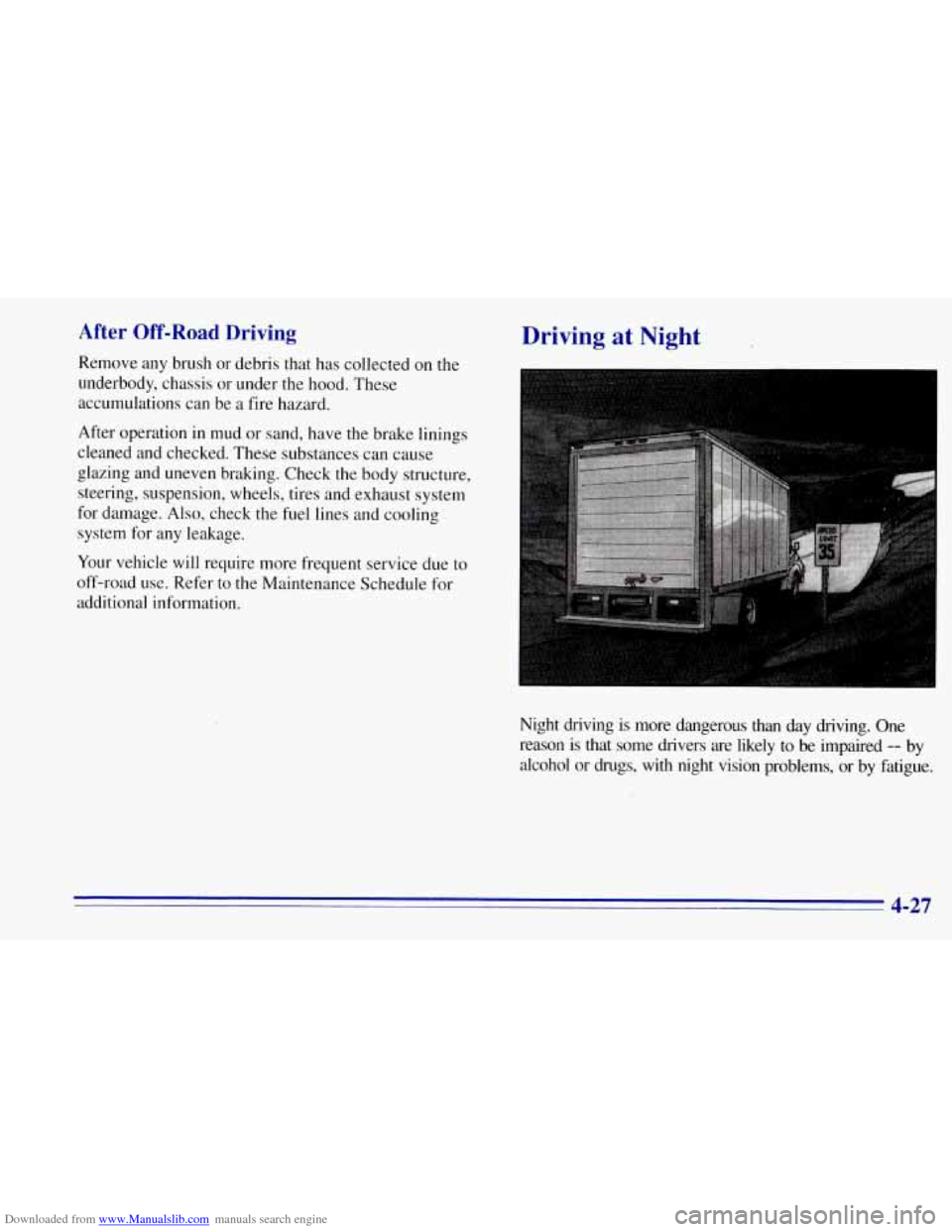
Downloaded from www.Manualslib.com manuals search engine After Off-Road Driving
Remove any brush or debris that has collected on the
underbody, chassis or under the hood. These
accumulations can be a fire hazard.
After operation in mud or sand, have the brake linings
cleaned and checked. These substances can cause
glazing and uneven braking. Check the body structure,
steering, suspension, wheels, tires and exhaust system
for damage. Also, check the fuel lines and cooling
system for any leakage.
Your vehicle will require more frequent service due to
off-road use. Refer to the Maintenance Schedule for
additional information.
Driving at Night
Night driving is more dangerous than day driving. One
reason is that some drivers are likely to be impaired
-- by
alcohol or drugs, with night vision problems, or by fatigue.
Page 194 of 403
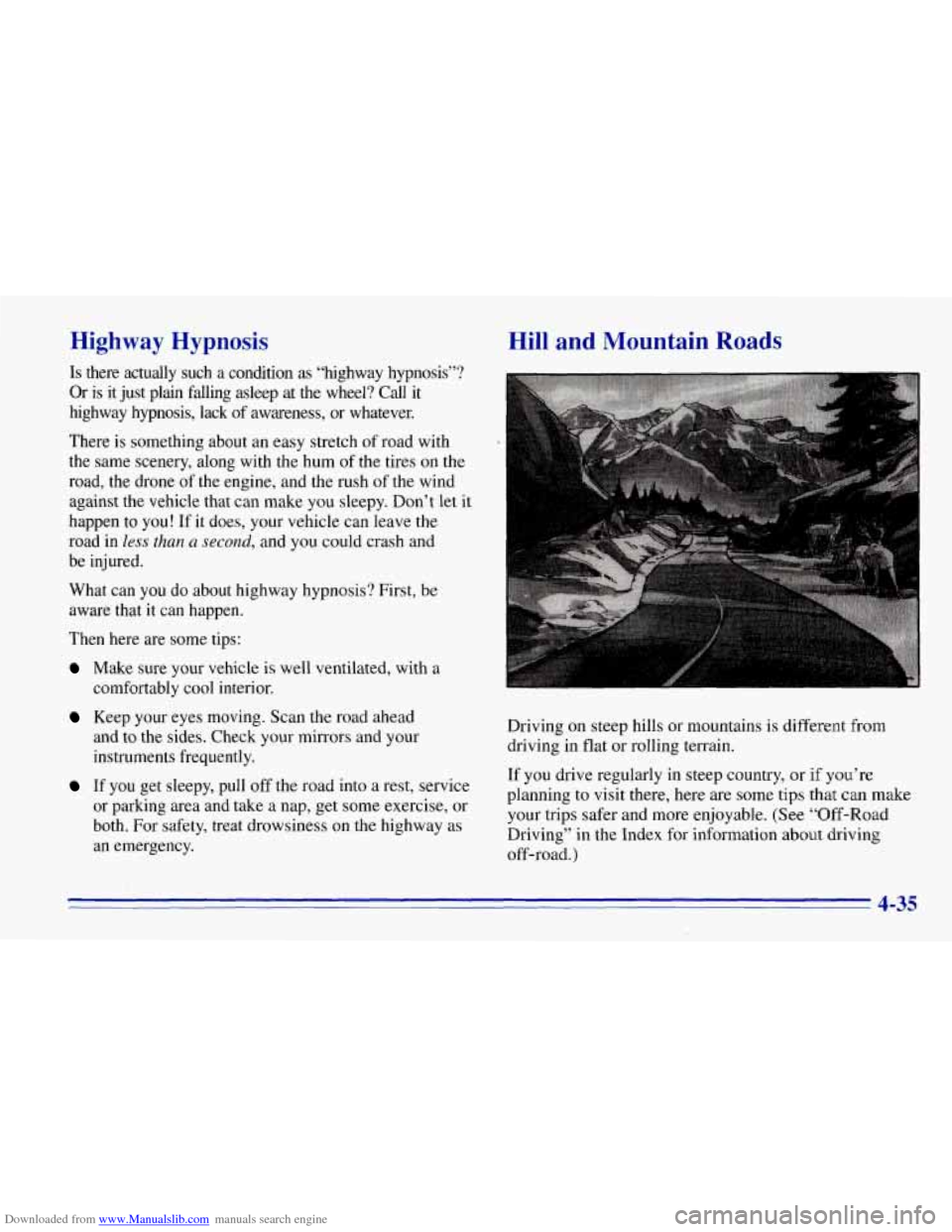
Downloaded from www.Manualslib.com manuals search engine Highway Hypnosis
Is there actually such a condition as “highway hypnosis”?
Or is it just plain falling asleep at the wheel? Call it
highway hypnosis, lack of awareness, or whatever.
There is something about an easy stretch of road with
the same scenery, along with the hum
of the tires on the
road, the drone
of the engine, and the rush of the wind
against the vehicle that can make you sleepy. Don’t let it
happen to you! If it does, your vehicle can leave the
road in
2ess than a second, and you could crash and
be injured.
What can you do about highway hypnosis? First, be
aware that it can happen.
Then here are some tips:
Make sure your vehicle is well ventilated, with a
comfortably cool interior.
Keep your eyes moving. Scan the road ahead
and to the sides. Check your mirrors and your
instruments frequently.
If you get sleepy, pull off the road into a rest, service
or parking area and take a nap, get some exercise,
or
both. For safety, treat drowsiness on the highway as
an emergency.
Hill and Mountain Roads
Driving on steep hills or mountains is different from
driving in flat or rolling terrain.
If you drive regularly in steep country, or if you’re
planning to visit there, here are some tips that can
make
your trips safer and more enjoyable. (See “Off-Road
Driving”
in the Index for information about driving
off-road.)
4-35